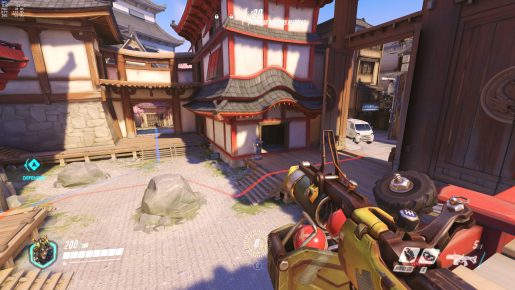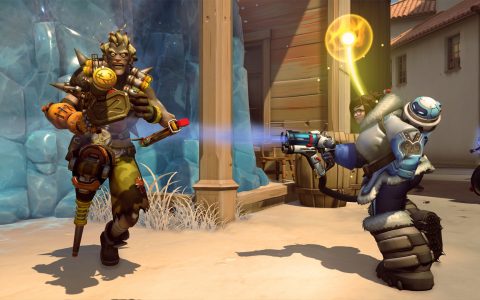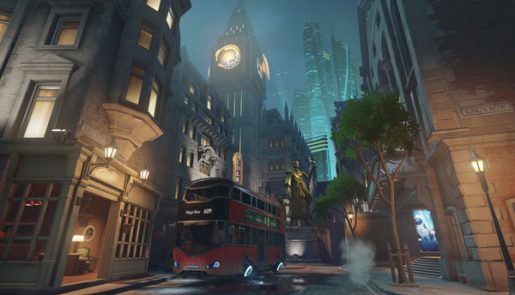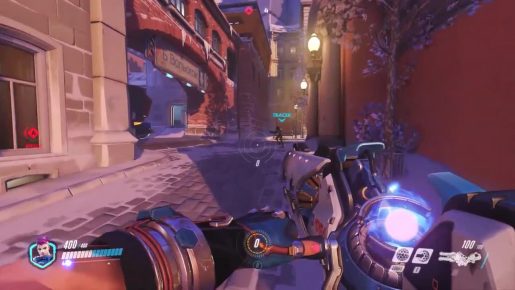Overwatch is the brand new squad-based first person shooter title from Blizzard, which pits two teams of 6 heroes against each other. Each team is equipped with unique weaponry, heroes must use their special abilities to, as a team, either attack or defend objectives. It sounds like a tried and tested formula but Overwatch manages to add its own flair, whilst drawing on inspiration from similar games.
A simple way of describing Overwatch would be an first person shooter which is reminiscent of Valve’s iconic Team Fortress 2, but with a wider variety of characters to choose from. Heroes are broken down into fairly standard roles of Offensive, Defensive, Tank and Medic: although, some heroes seem to fall outside of these set roles and can be utilized for both attack and defense. Bastion for example can turn himself into a turret and help defend a point from oncoming attackers. He sounds perfect for defense yet, by using his ultimate, he can change form into a tank and clear a defending team off an objective point. Despite the fact that he is a defensive styled character, as with a number of the heroes in Overwatch, Bastion can wreak havoc if played in an offensive style.
The map designs also aids this potential havoc. Players can flank an unobservant enemy team and take players out from behind. It can be easy to rack up a few significant kills by getting an otherwise defensive hero, or any hero for that matter, behind enemy lines. Levels are designed with balance in mind. Different characters are suited to sections of maps, with some able to pick targets off at range, great for large open sections, and other dominate in close quarters, due to their weaponry or abilities.
Upon learning about the lack of a generic sprint button I must admit I was dubious, however instead of closing the door on a feature it opens up a new world of power-based potential. Without having a sprint ability tanks feel noticeably heavier and slower, with the faster heroes with dash or sprint like abilities able to dart around the map. Instead of noticing when a character lacks the ability to sprint you instead notice when you can speed around the map. It also allows units without sprint to benefit from powers such as shields or secondary explosives, so can be seen as more of a balancing feature than a lack of one.
One noob-friendly feature is that even without gaining kills, or objective points, players ultimate ability charges slowly over time. This charge up time can be dramatically reduced by being effective on the battleground, but even those having a bad game can still, eventually, get a chance to use their strongest ability. Not only does this help new players but acts as a chance card for losing teams that may help them change the tide of the match. This is less likely as a dominate team will get their ultimate abilities faster and more frequently, but the potential is there, if the winning team becoming careless or overly cocky, for a team that is far behind to mount a comeback.
Visually Overwatch utilizes a clear, colourful and cartoony style which impeccably fits the game’s fun fast paced nature. Each map is characteristically different from the next, drawing inspiration from real world locations but with futuristic and over exaggerated twists. The style will enable the game to age well over time, as it is far from realistic textures that will in years to come look old and pixelated. The heroes also employ this over exaggerated style to portray over the top individuals. This gives a personality to each hero that fits their exclusive abilities and is only amplified by the unique and entertaining voice lines they use.
The majority of Overwatch’s heroes are easy to understand, perfect for gamers who want to pick up and play the game. A few have abilities which are harder to use but once players have perfected how to use them on the battlefield are more than competent heroes that spice up the gameplay. Mercy is a great example: some players will struggle to immediately adjust to having, at best, limited attack damage. This all adds together to give a larger variety of team compositions, which only increases as players learn how to play a wider range of characters, and therefore adds variation to the title.
In design Overwatch does slightly feel like a free-to-play game, in the sense that it is like a first person shooter version of Heroes of the Storm. Thankfully, after buying the game all the heroes are instantly available to you. Despite the fact that there are loot boxes to purchase, there is no pay to win aspect in Overwatch. The loot boxes, which are otherwise gained by levelling up, only offer cosmetic style items including new voice lines, player tags and hero outfits. These are nice to have but have no effect on gameplay. They add something for players to work towards and unlock over time, in addition to allowing players some customisability.
VERDICT
 From the map designs to the current balance of heroes Blizzard have done an amazing job. The game is at its core fun to pick up and play whilst offering enough for players to want to continue playing and mastering the harder to learn heroes. For all of Overwatch’s quality and the entertainment the level of support it has in the future will see if it truly deserves to be put in the same class as games such as Team Fortress 2, which has been played for year since its release. Blizzard have commented that downloadable content will be free for all players, with new characters and maps being part of that content. Nevertheless, it is how frequent these content drops occur and if the team is quick to react to balance issues that will truly decide if Overwatch can stay as top dog.
From the map designs to the current balance of heroes Blizzard have done an amazing job. The game is at its core fun to pick up and play whilst offering enough for players to want to continue playing and mastering the harder to learn heroes. For all of Overwatch’s quality and the entertainment the level of support it has in the future will see if it truly deserves to be put in the same class as games such as Team Fortress 2, which has been played for year since its release. Blizzard have commented that downloadable content will be free for all players, with new characters and maps being part of that content. Nevertheless, it is how frequent these content drops occur and if the team is quick to react to balance issues that will truly decide if Overwatch can stay as top dog.
[Editor’s Note: Overwatch was reviewed on the PC. The game was provided to us by the publisher for review purposes.]




